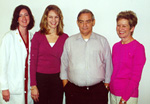Daughter gives father half of her own liver
by Lynne LangleyOf The Post and Courier staff
Mount Pleasant resident Tina Roberts saved her father's life last month by giving him half her liver, the first living donor adult liver transplant in this state.
She knew the surgery was risky: donors died in three of the 300 transplants
performed so far in the western
hemisphere.
 Pictured
from left are: Teresa Potter, transplant coordinator, Tina Roberts, Thomas
Setzer, and wife, Joyce.
Pictured
from left are: Teresa Potter, transplant coordinator, Tina Roberts, Thomas
Setzer, and wife, Joyce.
She also knew her father, North Charleston resident Thomas Setzer, would not live long without a transplant. He might not survive one more episode of bleeding, his doctors told the family.
I feel changed by it all, said the 32-year-old physical therapist and mother of two. Not too many people get a chance to save a life and live to tell about it.
His daughter and wife Joyce teamed up, Setzer said Monday with a smile. They told him, It's going to be done. The question wasn't if she would undergo the donor surgery but when, she said. The Feb. 15 double surgery took 14.5 hours at the Medical University of South Carolina.
After his staples were removed Monday morning, the 52-year-old upholstery business owner reported, I feel real good.
A transplant and organ donation usually follow a death, but the 16,000 Americans on the liver waiting list far exceed the 4,500 transplants each year.
So surgeons, first in Japan and now in Europe and this country, are turning to live donors. Unlike other organs, a partial liver grows back to normal size within a few weeks.
The MUSC liver transplant team performed the first in the state last November when Dr. Todd Walter of Landrum gave a small part of his liver to his 4-year-old daughter, Elizabeth.
Both are doing well, and the team recently completed a second pediatric transplant.
An adult, however, needs a full half of a donor's liver, the entire right side, Dr. Prabhakar Baliga said. The surgeon must preserve an artery, a vein and a bile duct, then clamp off and remove half the liver while causing minimal blood loss and complications.
It's very challenging, he said. Meanwhile, Setzer's diseased liver had to be removed before his daughter's was implanted, requiring three intricate operations, Dr. Jeffrey Rogers said.
It was the Superbowl of liver transplants. And it worked perfectly, said Dr. Ken Chavin, Roberts' primary surgeon. It went off without a hitch.
Because Setzer had his own living donor, his doctors could choose the ideal time. They operated while he was stable and had a better chance of recovering than do many patients, who grow increasingly ill as they slowly move up a long waiting list, Baliga said.
Baliga expects more live donor liver transplants due to the organ shortage and the growing success of the new type of transplant. In New York, 30 percent of the liver transplants have been from live donors in the last six months, he said.
Just eight years ago, eight or 10 MUSC patients were waiting for liver transplants. The number has grown tenfold since then, yet cadaver donations have only doubled, he said.
For Roberts, the final, convincing word came from her older son, 9-year-old Dane. He told her, I want my grandfather to be here.
Editor's note: The article ran March 13 in the Post and Courier and
is reprinted with permission.